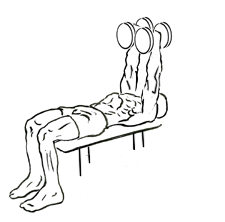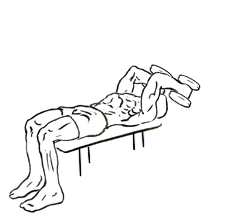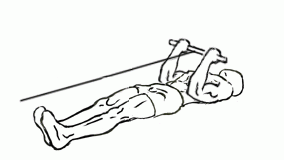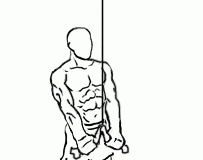Last Updated on September 24, 2014
The Lying Two-Arm Triceps Extension with Dumbbell is a powerful variation of the classic triceps extension. It’s a move that targets the triceps effectively by isolating the muscle and utilizing gravity to increase resistance. This exercise, often seen as a lying version of the Triceps Kickback, is an excellent choice for anyone aiming to build triceps strength, definition, and stability. Adding this exercise to your routine can help you achieve stronger arms and balanced upper body aesthetics.
In this comprehensive guide, we’ll dive into the benefits, technique, common mistakes, variations, and ways to incorporate the Lying Two-Arm Triceps Extension into your workout program.
Why the Lying Two-Arm Triceps Extension is Essential
Triceps strength is crucial for both aesthetics and functionality. The triceps, located at the back of the upper arm, make up roughly two-thirds of arm mass. A stronger triceps group contributes to improved performance in pressing exercises like the bench press, shoulder press, and push-ups, all of which rely on triceps support. This exercise also contributes to arm definition, creating the desired balance in arm aesthetics by focusing on the muscle often responsible for “toned” arms.
Anatomy of the Triceps
Understanding the anatomy of the triceps helps in realizing why this exercise is effective:
- Long Head: Runs along the back of the arm, originating at the shoulder blade. This head is heavily engaged in overhead triceps movements.
- Lateral Head: Positioned on the outer part of the triceps, contributing to the muscle’s “horseshoe” shape.
- Medial Head: Located beneath the long and lateral heads, it provides stability and assists in overall elbow extension.
The Lying Two-Arm Triceps Extension primarily targets all three heads but especially emphasizes the long head, leading to overall triceps development and improved arm strength.
Benefits of the Lying Two-Arm Triceps Extension with Dumbbell
This exercise offers several benefits that make it a valuable addition to any strength-training routine:
- Isolates the Triceps: With minimal shoulder or chest involvement, this exercise isolates the triceps, maximizing muscle engagement.
- Improves Stability: The controlled movement requires stabilizer muscles in the shoulders and core to engage, promoting overall upper-body stability.
- Enhances Arm Definition: Regularly performing triceps isolation exercises like this one can help improve arm tone and definition.
- Increases Joint Stability: The movement helps strengthen the tendons and ligaments around the elbow joint, essential for upper-body strength and injury prevention.
Step-by-Step Guide to Performing the Lying Two-Arm Triceps Extension with Dumbbell
Step 1: Set Up Your Position
- Lie on a Flat Bench: Position yourself on a flat bench with your head at one end. Keep your feet planted firmly on the floor to provide a stable base throughout the movement.
- Select Appropriate Weights: Start with lighter dumbbells, especially if you’re new to the movement. This allows you to get comfortable with the form before adding more resistance.
Step 2: Grip the Dumbbells
- Grasp the Dumbbells with a Neutral Grip: Hold a dumbbell in each hand with a neutral grip (palms facing each other). This grip is gentler on the wrists and elbows while allowing for better control.
- Extend Arms Toward the Ceiling: Raise the dumbbells above your shoulders, with arms fully extended. Keep a slight bend in your elbows to prevent locking them out, which can place stress on the elbow joints.
Step 3: Engage the Triceps and Lower the Dumbbells
- Lower the Dumbbells in an Arc: Begin bending your elbows to lower the dumbbells in a controlled arc, bringing them down towards your forehead or slightly behind your head. Imagine creating a semicircular motion as you lower the weights.
- Keep Your Upper Arms Stationary: Avoid moving your upper arms or shoulders; the motion should come only from your elbows. This keeps the focus on the triceps and prevents other muscles from taking over.
Step 4: Pause and Return to the Starting Position
- Pause at the Bottom: Once your forearms are near your biceps, hold briefly to maximize the stretch in your triceps.
- Extend the Dumbbells Back Up: Using your triceps, extend your arms to return to the starting position, keeping the motion smooth and controlled. Avoid locking your elbows at the top to keep tension on the triceps.
Repeat for the desired number of reps, maintaining control and a steady tempo throughout.
Tips for Perfecting Your Form
Perfecting your form is essential for maximizing results and minimizing injury risk. Here are some key tips to keep in mind:
- Maintain a Controlled Descent: Lowering the weights too quickly can place unnecessary stress on your joints and reduces muscle activation. Control the descent for maximum tension on the triceps.
- Avoid Elbow Flaring: Keep your elbows tucked in close to your body. Flaring them outward can reduce triceps activation and increase shoulder strain.
- Focus on Breathing: Inhale as you lower the dumbbells and exhale as you extend them back up. Proper breathing helps with stability and control.
- Engage the Core: Keep your core muscles activated to support your lower back and prevent any unnecessary movement.
Common Mistakes and How to Avoid Them
Even experienced lifters can make mistakes with this exercise. Avoid these common errors:
- Using Excessive Weight: Going too heavy can lead to form breakdown, making the exercise less effective and increasing injury risk. Start with a moderate weight, focusing on form before adding load.
- Moving the Upper Arms: The upper arms should remain stationary throughout the movement. If your upper arms are moving, it means your shoulders are contributing to the lift, reducing triceps isolation.
- Rushing the Movement: This is a controlled, slow-movement exercise. Rushing through reps reduces time under tension, limiting muscle growth.
- Dropping the Elbows Too Low: Lower the dumbbells only to a point where you feel a good stretch in the triceps. Overextending can strain the shoulders.
Variations of the Lying Two-Arm Triceps Extension
To add variety and further challenge your triceps, consider these variations:
1. Single-Arm Lying Triceps Extension
Perform the exercise with one arm at a time, using a single dumbbell. This version helps correct any muscle imbalances between arms and increases core engagement as you stabilize the body.
2. Incline Lying Triceps Extension
Perform the exercise on an incline bench to target the long head of the triceps more effectively. The incline angle changes the line of resistance, adding variety to your triceps training.
3. Lying Triceps Extension with a Barbell
Use a barbell or EZ (curl) bar instead of dumbbells for a different grip. The barbell can allow for heavier lifting and provides a more stable grip, making it a good choice for those focused on strength.
4. Reverse Grip Lying Triceps Extension
Hold the dumbbells with an underhand grip (palms facing your head). This variation emphasizes the medial head of the triceps and provides a different stimulus to the muscle.
Sample Triceps Workout Routine
Here’s a balanced triceps workout that incorporates the Lying Two-Arm Triceps Extension:
- Warm-Up: 5-10 minutes of light cardio and dynamic stretches focusing on the upper body.
- Triceps Pushdown (Cable): 3 sets of 10-12 reps
- Overhead Dumbbell Extension: 3 sets of 10 reps
- Lying Two-Arm Triceps Extension with Dumbbell: 3 sets of 8-12 reps, focusing on controlled movement
- Close-Grip Bench Press: 3 sets of 8-10 reps to work both the triceps and chest
- Dips: 2 sets to failure for a triceps burnout
Safety Tips for the Lying Two-Arm Triceps Extension
Since this exercise involves holding weights above your head, safety should be a priority:
- Use a Spotter if Lifting Heavy: If you’re using heavier weights, consider having a spotter to assist if needed, especially as you near the end of a set.
- Warm Up Properly: Always warm up before performing any triceps isolation exercise to reduce the risk of injury.
- Avoid if Fatigued: If your triceps are already fatigued, save this exercise for another session to prevent form breakdown and injury.
Progressive Overload Techniques
Progressive overload helps ensure consistent strength gains. Apply these techniques to keep improving:
- Gradually Increase Weight: Add weight incrementally as your triceps become stronger, focusing on maintaining proper form.
- Add Reps or Sets: Once you’re comfortable with your current weight, try increasing the number of reps or sets.
- Pause at the Bottom: Adding a brief pause at the bottom of each rep increases time under tension, enhancing muscle growth.
Integrating the Exercise into Different Workouts
The Lying Two-Arm Triceps Extension is a versatile exercise that can be incorporated into various training splits:
- Push Day: Combine with chest and shoulder exercises to work the pressing muscles.
- Arm Day: Include alongside biceps exercises to create a balanced arm-focused workout.
- Upper Body Day: Pair it with compound upper-body exercises like bench presses, shoulder presses, and rows to ensure that your triceps receive dedicated isolation work while also supporting multi-joint movements.
Adding the Lying Two-Arm Triceps Extension to these different types of workouts ensures that you effectively target your triceps while still building overall upper-body strength.
Tracking Your Progress for Continuous Improvement
Monitoring your progress can help you make consistent gains and avoid plateaus. Keep an eye on these aspects as you perform the Lying Two-Arm Triceps Extension:
- Reps and Sets: Track the number of reps and sets completed, noting when you increase reps or add an extra set.
- Weight Progression: Document the weight used for each set. Slowly increasing the weight, even by small increments, can signify strength development.
- Range of Motion and Control: Pay attention to your range of motion over time. As flexibility and strength improve, you may notice a deeper stretch or greater control during each rep.
- Tempo and Technique: Experimenting with slower tempos or adding pauses at specific points in the movement can make the exercise more challenging and effective. Tracking these variations helps you understand what adjustments work best for muscle activation.
Frequently Asked Questions (FAQs)
1. Can beginners perform the Lying Two-Arm Triceps Extension with Dumbbell?
- Yes, but beginners should start with lighter weights to prioritize form over load. Once comfortable with the movement, they can increase weight gradually.
2. Should I use dumbbells or a barbell for this exercise?
- Dumbbells allow for greater freedom of movement, reducing wrist and shoulder strain, and promoting balanced development between arms. A barbell is also effective but may limit range of motion.
3. How often should I include this exercise in my workouts?
- Performing this exercise once or twice a week is typically sufficient, especially when combined with other triceps and upper-body exercises. Allow time for recovery, as the triceps need rest to grow stronger.
4. Can I perform this exercise without a bench?
- Yes, but using a flat bench offers better range of motion and stability. If you don’t have access to a bench, lying on a firm surface such as a mat will work in a pinch, though the range may be limited.
5. What if I experience discomfort in my elbows?
- If your elbows feel strained, check your form and ensure that you’re not locking out at the top or flaring your elbows outward. Lowering the weight and focusing on controlled movement can also help minimize strain.
Final Thoughts
The Lying Two-Arm Triceps Extension with Dumbbell is a valuable exercise for anyone looking to build strong, defined triceps and a balanced upper body. With proper form and progressive overload, this exercise can help you achieve the muscular arms and upper-body strength you’re aiming for. Remember to start light, prioritize control over speed, and integrate this exercise into a well-rounded workout routine to see the best results.
Incorporate the tips, techniques, and variations discussed here, and you’ll be on your way to stronger, more defined triceps in no time. Stay consistent, focus on form, and enjoy the journey toward improved arm strength and aesthetics with the Lying Two-Arm Triceps Extension with Dumbbell.








